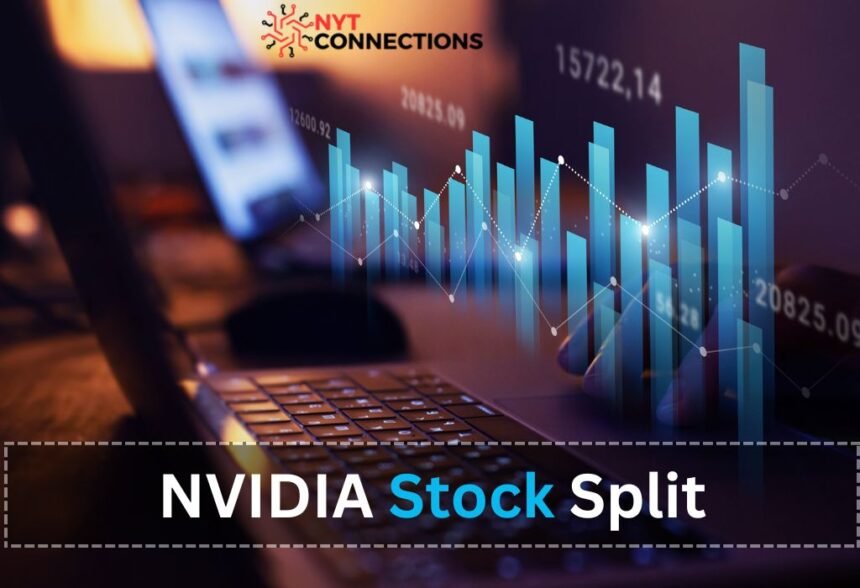Investors worldwide have been captivated by NVIDIA’s success in technology and AI advancements. The NVIDIA stock split has become a hot topic among financial experts and retail investors alike. Stock splits have long been a method for companies to make shares more accessible and maintain market interest.
This article explores the concept of stock splits, NVIDIA’s specific approach, and how it affects shareholders and the broader market. From the history of NVIDIA stock splits to actionable investment strategies, this guide covers all you need to know.
What is a Stock Split?
A stock split is when a company divides its existing shares into smaller units to increase the total share count while keeping its overall market capitalization constant. For instance, in a 4-for-1 stock split, one share is divided into four, reducing the price per share while maintaining the same total value.
NVIDIA uses stock splits to keep its shares affordable and attract investors at all levels.
NVIDIA Stock Splits: History and Key Details
Historical Stock Splits
NVIDIA has a rich history of stock splits, reflecting its growth trajectory and commitment to shareholder value. Below is an overview:
| Date | Split Ratio | Price Before Split | Adjusted Price |
|---|---|---|---|
| June 27, 2000 | 2-for-1 | Approx. $50 | $25 |
| September 11, 2001 | 2-for-1 | Approx. $80 | $40 |
| July 20, 2007 | 3-for-2 | Approx. $30 | $20 |
| July 20, 2021 | 4-for-1 | Approx. $750 | $187.50 |
Each split came at a critical growth stage, ensuring accessibility for retail investors and bolstering trading volume.
Why Does NVIDIA Perform Stock Splits?
Purpose and Benefits
Stock splits aim to:
- Enhance Accessibility: Lower share prices allow smaller investors to participate.
- Increase Liquidity: More shares mean higher trading volume.
- Signal Growth: Companies with consistent performance often execute splits to maintain shareholder interest.
For NVIDIA, stock splits are a strategy to reflect confidence in its financial health and future potential.
Impact of NVIDIA Stock Splits on Shareholders
Stock splits don’t increase the intrinsic value of a company but can positively affect shareholders. Here’s how:
- Lower Entry Barrier: Investors can buy more shares without requiring large amounts of capital.
- Improved Liquidity: Easier trading due to higher availability of shares.
- Potential Price Increase: Stock splits often boost demand, temporarily increasing prices.
Advantages of NVIDIA Stock Splits
- Market Accessibility: Splits make shares more affordable, attracting a larger pool of investors.
- Enhanced Trading Volume: Increased shares often lead to higher activity on trading platforms.
- Positive Investor Sentiment: A stock split signals confidence in long-term growth, encouraging investment.
Bio Table: NVIDIA Stock Splits at a Glance
| Aspect | Details |
|---|---|
| Company Name | NVIDIA Corporation |
| Ticker Symbol | NVDA |
| Industry | Technology (Semiconductors, AI) |
| First Stock Split | June 27, 2000 |
| Most Recent Split | July 20, 2021 |
| Total Splits | 5 |
| Largest Split Ratio | 4-for-1 (2021) |
| Primary Purpose | Increase market accessibility and shareholder value |
| Market Capitalization | Over $1 trillion (as of 2025) |
How NVIDIA Stock Splits Affect Small Investors
Small investors benefit significantly from stock splits. By reducing the cost per share, NVIDIA allows retail investors to gain a stake in the company without needing to purchase fractional shares.
For instance, a 4-for-1 stock split makes a $1,000 share accessible at $250, attracting a more diverse range of investors.
Post-Split Performance of NVIDIA Stocks
NVIDIA has consistently demonstrated strong performance after its stock splits. In the year following its 2021 split, the company experienced:
- Revenue Growth: Driven by AI and gaming technologies.
- Investor Confidence: Increased trading volume and a higher number of shareholders.
These trends highlight the value of NVIDIA’s growth-oriented strategy and its alignment with market expectations.
Comparison with Other Tech Giants
NVIDIA’s stock split strategy mirrors those of Apple and Tesla, two tech giants that have successfully used splits to democratize share ownership.
| Company | Most Recent Split Ratio | Impact on Price |
|---|---|---|
| Apple | 4-for-1 (August 2020) | Increased accessibility; long-term growth |
| Tesla | 5-for-1 (August 2020) | Short-term price surge; broader investor base |
| NVIDIA | 4-for-1 (July 2021) | Steady growth post-split; higher trading volume |
How to Invest After NVIDIA’s Stock Split
Key Investment Strategies
- Long-Term Approach: NVIDIA’s leadership in AI and gaming suggests strong future potential.
- Research Fundamentals: Review earnings reports, growth drivers, and analyst ratings.
- Diversify Portfolio: Balance NVIDIA shares with other high-performing assets.
Risks Associated with NVIDIA Stock Splits
While stock splits have advantages, investors should be cautious about:
- Misinterpretation: A stock split doesn’t guarantee increased value.
- Short-Term Volatility: Splits can lead to temporary fluctuations in stock prices.
Future Outlook for NVIDIA Stocks

The outlook for NVIDIA remains robust, with growth driven by:
- Artificial Intelligence: Expanding applications across industries.
- Gaming: Increasing demand for high-performance GPUs.
- Data Centers: Rising reliance on cloud computing and AI workloads.
FAQs
Q1: Why does NVIDIA perform stock splits?
NVIDIA splits its stock to increase accessibility, enhance liquidity, and maintain investor interest.
Q2: How many times has NVIDIA split its stock?
NVIDIA has conducted five stock splits, with the most recent in July 2021.
Q3: Does a stock split increase NVIDIA’s value?
No, a stock split doesn’t change the company’s market capitalization but makes shares more affordable.
Q4: How do NVIDIA stock splits compare to other tech companies?
NVIDIA’s splits align with strategies used by Apple and Tesla, focusing on accessibility and growth.
Q5: Should I buy NVIDIA shares after a split?
It depends on your financial goals and the company’s fundamentals. Conduct research before investing.
Q6: What industries drive NVIDIA’s growth?
NVIDIA leads in AI, gaming, data centers, and autonomous vehicles.
Conclusion
The NVIDIA stock split is more than just a financial event—it’s a reflection of the company’s growth and future potential. By understanding the mechanics and implications of stock splits, investors can make informed decisions to capitalize on NVIDIA’s long-term success.





